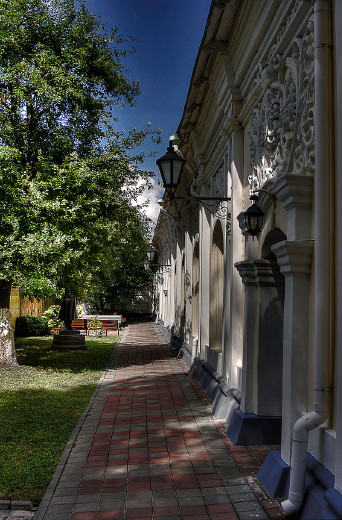Pereiaslav College
Pereiaslav College (Переяславський колеґіюм; Pereiaslavskyi kolegiium). An educational institution in Pereiaslav that functioned in the 18th and early 19th centuries and combined elements of upper secondary education and higher education. Along with the name ‘college,’ it was also called ‘the Pereiaslav school,’ ‘Slavo-Latin School,’ ‘seminary,’ and ‘academy.’ It was founded in 1738 by Bishop Arsenii Berlo, who stressed in the institution’s decree that the establishment of this college was not his personal wish as a church dignitary, but rather a ‘common necessity,’ while also stating that this initiative needed ‘support from the community’ to be brought to fruition.
The college was initially housed in a wooden building within the premises of the Ascension Monastery in Pereiaslav. In 1753, local Bishop Ioan Kozlovych took measures to set about the construction of its new brickwork building that was subsequently enlarged and decorated with stucco moulding and symbolic images in 1782–83. Since 1972, it has been the location of the Hryhorii Skovoroda Memorial Museum, in which some of the college’s classrooms and its library have been reconstructed.
The educational practices at Pereiaslav College followed the patterns typical of the Kyivan Mohyla Academy and foresaw the pupils’ consecutive mastering of grammar, poetics, rhetoric, philosophy, and theology in respective classes. In essence, it mirrored the Ratio Studiorum as applied in Jesuit colleges. The grammar classes were mainly focused on instructions in Latin; other subjects included Church Slavonic, arithmetic, singing from sheet music, catechism, Polish (from 1738 on), German (from 1763 on), and French (from the early 1780s on). The study of rhetoric and poetics was an instrument of further improving the mastery of Latin as well as of the ethical moulding of the pupils.
One of the courses in poetics and rhetoric, offered by Pylyp Hoshkevych in 1742 and written down by a student, was entitled ‘Hortus Musarum’ (‘A Garden of the Muses’). Hryhorii Skovoroda taught classes in poetics during the 1753–54 academic year. In the second half of the 18th century, a few changes were made to the list of subjects taught in the classes of poetics and rhetoric. This list was supplemented with history, geography, mathematics, Russian, and Ancient Greek (from 1784). Instruction in philosophy was introduced in 1773 and carried out in the spirit of the Leibnizian-Wolffian system, as the latter was expounded in the textbooks by Friedrich Christian Baumeister (1709–1785). Theology was added to the curriculum in 1781, with Varlaam Shyshatsky serving as the first ever professor of theology at the college. In the early 19th century, pastoral theology, canon law, church history, and hermeneutics were also included in the basic course of study. Local Bishop Sylvestr Lebedynsky later issued a recommendation that theology be taught from his own manual, Sacra Theologia, first published in 1799. Debates in Latin were a routine part of the lessons in the classes of both philosophy and theology. Closed by reason of the discontinuation of the Pereiaslav eparchy in 1785, they were reopened following its restoration (philosophy in 1799, theology in 1800).
Apart from the progeny of the clergy, the college equally accepted Cossacks’ sons, as well as youth of other social origins. During the first decades of its existence, the number of students oscillated between 120 and 130; by the end of the 18th century it grew to its historical maximum of over 700. The extant documentation indicates that several generations of the representatives of the notable local Bazylevych, Isaievych, Petrovsky-Bakhchevsky, and Lebedev families did their studies at the college. Its graduates held both ecclesiastical and secular offices.
The college possessed a separate house that served as a bursa for state-aided students, whose description is given by Vasyl Narizhny in his autobiographical short novel Bursak (The Bursa Resident, 1824).
The college’s teaching staff included some prominent churchmen: Varlaam Shyshatsky (later Bishop of Volhynia and Zhytomyr, and subsequently Archbishop of Belorussia), Epifahii Kenietsky (later rector of the Kazan Ecclesiastical Academy and Bishop of Voronezh), Yoakynf Lohanovsky (later rector of the Kyivan Mohyla Academy), Iraklii Komarovsky (Bishop of Chernihiv), Anastasii Savynsky (later professor of the Aleksandr Nevsky Seminary in Saint Petersburg), as well as prominent preacher and writer Ivan Levanda. The lecturer in Latin Stepan Hrechyna (Hrechka) was characterized by Illia Tymkivsky (graduate of Pereiaslav College and subsequently professor at Kharkiv University) as an ‘outstanding Latinist of his time’; he presumably served as a prototype for the main character in Taras Shevchenko’s novella ‘Bliznietsy’ (The Twins, 1855).
The college possessed a well-stocked library numbering over 1,500 volumes by the turn of the 19th century.
The 1808 reform of religious education in the Russian Empire brought with it the transformation of the college into a theological seminary, which obtained its new statute in 1817.
BIBLIOGRAPHY
Levitskii, Parfenii. ‘Proshloe pereiaslavskago dukhovnago uchilishche’ in Kievskaia starina 2 (1889)
Parkhomenko, Vladimir. Ocherki istorii Pereiaslavsko-Borispolskoi eparkhii (1733–1785) (Poltava 1910)
Posokhova, Liudmyla. Na perekhresti kul'tur tradytsii, epokh: pravoslavni kolehiiumy Ukraïny naprykintsi XVII – na pochatku XIX st. (Kharkiv 2011)
Liudmyla Posokhova and Serhii Vakulenko
[This article was updated in 2023.]
